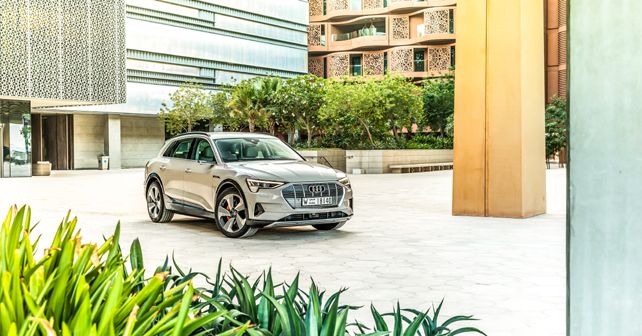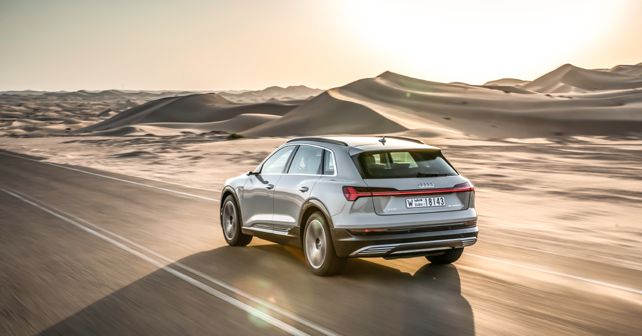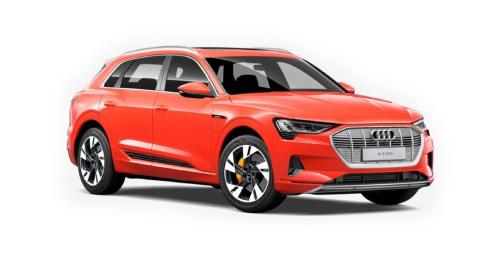Audi’s first electric car is finally here. Should Tesla be worried?
So far, Tesla has had it all its own way. It’s become the poster child for electric mobility. Well, to be fair, Tesla has singlehandedly made the electric car sexy and desirable. So, in that sense, the established automakers owe it a debt of gratitude. However, it’s also the upstart that’s turned the entire industry on its head. It’s no surprise, then, that the establishments have their guns trained.
We drove the all-electric Jaguar I-Pace in mid-2018 and were hugely impressed. Jaguar had beaten its German rivals to the punch by launching a production EV – and it was brilliant. It became immediately clear that the established automakers would be giving Tesla founder, Elon Musk, many more sleepless nights – even once he’s overcome the ‘production hell’ of the Model
But there’s one distinct difference between all the Teslas, the Jaguar and the Audi we have here. You see, the Audi e-tron is actually coming to India. It’ll be launched a year from now – at the end of 2019, or early 2020. Of course, it won’t be cheap. It’s expected to set you back well over a crore when it hits Audi’s Indian showrooms. So, will it be worth it?
It better be good!
You see, in the post-Dieselgate era, VW has put all its eggs in the EV basket – and the e-tron is Exhibit A. The VW Group has all but announced that they’re stopping further development on the IC engine, which is a bit of a shame since the EV infrastructure is yet to develop in large parts of the world – namely India – and Formula 1 has shown that thermal efficiency gains are still to be had in the world of internal combustion engines. Moreover, electric motors use rare earth metals – the supply chain for which is virtually monopolised by China. But, let’s leave geopolitics out of this review for the moment.
Whereas the Jaguar and Audi share essentially the same layout – a battery pack in the floor and a motor at each end, one for the front axle and another for the rear – there’s one very important difference between the two. The Jaguar uses two synchronous rare earth, permanent magnet motors, whereas the Audi uses two three-phase asynchronous motors that have no need for rare earth metals. Not only does that make it more sustainable, but also cheaper to produce. The disadvantage, however, being that it’s slightly bigger and heavier.
Not exactly radical in appearance
But, before we get into the technicalities, let’s start with the basics – how does it look? Well, it’s modern and striking, but not radical or especially futuristic. The e-tron looks like it fits perfectly between the Q5 and Q7 in Audi’s SUV portfolio. It doesn’t exactly have falcon doors, like the Tesla Model X. But I think that’s a deliberate move by Audi – to ease people into their electric cars by ensuring that they fit in, while still being that little bit modern and edgy of course. And, in that vein, our test car had virtual wing mirrors. This is something that we’ve seen on concept cars for some time, but the e-tron is the first car to sport them in production spec. And I happen to think that they look really cool. Essentially, the wing mirrors are replaced with cameras on the outside, while the display for each is integrated into the top of the door pads.
And they haven’t just done this to be cool. Absolutely everything in this car is designed to cut through the air as efficiently as possible. It has a coefficient of drag of .28 with a set of standard wing mirrors, and a Cd of .27 with the virtual wing mirrors. Incidentally, it betters the Jaguar – which is .29 – but both are outdone by the Model X, which is ultra-slippery at .24.
On the inside, as you’d expect, the quality of materials in the Audi are exceptional. But, here again, the e-tron looks and feels very much like any other brand new, top-of-the-line Audi – with the exception, again, of the virtual wing mirrors. Looking at the displays in the door pads, by the way, becomes second nature very quickly. The e-tron will have to do without this party trick in India, however, as Indian regulations don’t permit the virtual wing mirrors.
The cabin is dominated by screens, which works well since the resolution of Audi’s screens – everything from the wing mirror displays to the instrument cluster and the centre console – are simply phenomenal. The trouble with massive screens on the centre console, though, is the fact that they very quickly become fingerprint magnets. Other than that, though, with haptic feedback and good functionality, they’re very intuitive and easy to use.
Of course, the one thing that strikes you in the cabin of an EV is the silence – and, on that front, the Audi excels. It has an acoustic windshield, so you can literally hear a pin drop in the cabin. Despite its massive tyres – 265/45 R21’s on our test car – there was virtually no motor, wind or tyre noise. The virtual wing mirrors work their magic here as well. Suffice to say, it’s quite serene in the cabin.
How fast is it?
The two motors combine to produce 300kW of power, which is the equivalent of just over 400 horsepower and 664Nm of torque. It has a 95kW/h battery pack that gives it a claimed range of 400 kilometres. 100km/h comes up in just 5.7 seconds in Boost mode, which is an 8-second surge of max power.
The I-Pace has a 90kW/h battery pack, but the interesting this is that both the Jag and the Audi battery packs consist of 432 pouch cells – I’m not sure why 432 is the magic number here. At any rate, the e-tron feels quite rapid from behind the wheel. In fact, because it’s so silent and refined, it’s deceptively fast – three-digit speeds come up before you know it. Top speed is limited to 200km/h to preserve range. What I can tell you is that 200 comes up very quickly indeed, and no matter what speed you’re doing, the e-tron continues to accelerate with some urgency. Suffice to say, on the highway, the e-tron is quite rapid and very well behaved. It also feels very normal and easy to drive. You just jump in and go, no fuss!
But that’s a double-edged sword. It’s good because adapting to an EV becomes a non-event. But the flip side is that the driving experience doesn’t really feel special. From behind the wheel, it certainly doesn’t give you any sense of the paradigm shift that it’s heralding.
Don’t get me wrong. Having full torque at zero rpm is addictive. The levels of refinement too, are something else. So, as a sustainable luxury runabout, the e-tron works exceedingly well and, with substantial range, fits into your daily life completely effortlessly. But, in seeking a middle ground for the e-tron, Audi may have robbed it of its sense of occasion.
Can an EV go off-road?
The rear motor is the dominant one in the e-tron. It’s only when additional power is needed that the second motor wakes up and powers the front wheels, making the e-tron all-wheel drive – which means that you can actually take it off-road. Audi had cleared a section of desert outside Abu Dhabi, on which the e-tron did very well – as long as you didn’t venture deep into the dunes, that is.
EV’s have an inherent balance because all the weight is low in the chassis – since the battery pack is in the floor. The e-tron not only has a low centre of gravity but also 50:50 weight distribution – making it very well behaved when provoked. The only fly in the ointment is the fact that it weighs 2.5 tonnes. The battery pack alone – since it has a crash structure built in – weighs 700 kilos. And you can certainly feel all that weight when you push it around corners. It remains well behaved, of course, but you can sense that it’s not exactly enjoying the experience. To keep this weight in check, the e-tron is fitted with air suspension, but despite that, the ride is firm and feels quite choppy on anything less than perfect tarmac.
Should you buy an EV?
Well, the short answer is yes. EVs don’t exactly provide a visceral driving experience, so ‘no’ if that’s what turns you on. But, if you want to be at the cutting edge of technology, and save the planet while you’re at it, the cars themselves demand no compromises.
Now we just have to make sure that the energy that goes into powering these machines is green, and that the infrastructure to support these vehicles follows. More than the cars themselves, that’s the million dollar question…
Should Tesla be worried?
Yes, they should. Without any baggage, Tesla still feels new and fresh – and perhaps more representative of the change that these machines are heralding – but there’s no denying that the established automakers are hot on its tail. And there’s also no denying the fact that they know how to churn out these machines by the millions – something Tesla is still struggling with.

- Audi e-tron
Motors: Two asynchronous electric motors – one for each axle
Battery capacity: 95kW/h
Transmission: Planetary gear set (single speed) / Electric All-Wheel Drive
Power: 300kW (408hp)
Torque: 664Nm
Top Speed: 200km/h
Acceleration: 0-100kmh – 5.7 seconds
Range: 400kms (claimed)
X-Factor: No compromise emissions-free motoring.
| Pros | Cons |




























Write your Comment